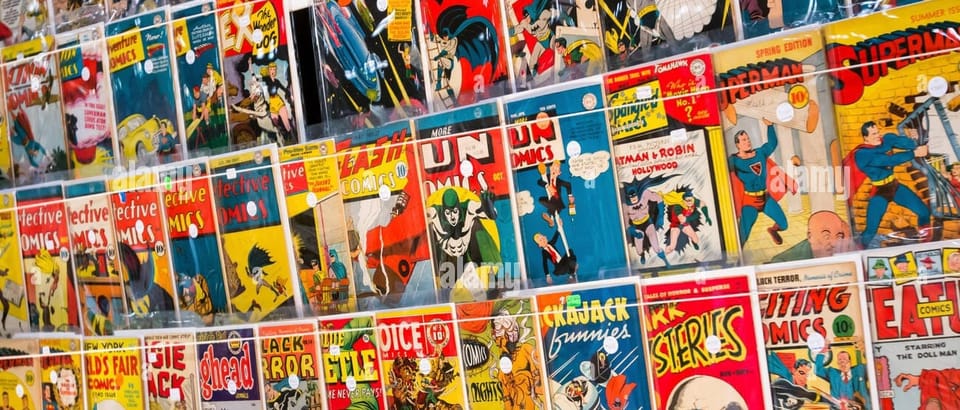Alt Asset Report #004 - Comic Books

Overview
- Focused on American superheroes, popularity exploded during WWII and directly referenced the war and fighting fascism
- This came after the original 10-cent novels of the old west and their own “superheroes”
- Captain America debuted by punching Hitler in the face
- Original Superman and Batman focused on fictional universes of Metropolis and Gotham City
- Nearly all Marvel characters live and work in New York City
- This grounds the comics in our reality - allowing them to reflect current social, political, and economic themes
- Recent rebirth due to character’s use in blockbuster movie and game franchises (Batman, Deadpool, Avengers, Spider-Man, etc.)
- Over $17 billion from Marvel franchises and almost $7 billion from DC franchises
- The even more recent trend indicates fatigue with superhero movies underperforming at the box office over the past few years
Investment Hypothesis
- Existing stories and IP allow for decades old comic book story arcs to be seamlessly adapted into new tv shows, movies, and video games - driving up character awareness and demand.
- Similar to collectables like sports cards, wine, and cars, local comic books stores have connected hobbyists since before the internet existed
- This creates a robust market to buy/sell
- It also leads to a more fragmented market, as many online marketplaces have grown from individual comic shops and are more of the mom-and-pop variety
- An example: The Batman franchise across media
- Active Comic Books
- Absolute Batman
- Batman: The Long Halloween: The Last Halloween - miniseries
- Batman/Superman: World’s Finest
- Batman & Robin Year One - miniseries
- Detective Comics
- The Batman and Scooby-Doo Mysteries - miniseries
- Batman and Robin (Vol. 3)
- Batman (Vol. 3)
- Batman: Full Moon - miniseries
- Video Games
- Batman: Arkham Series - 11 games over 15 years
- Movies
- TV
- The Penguin
- Gotham - from 2014 to 2019
- Batwheels
- Active Comic Books
Investment Factors
Bull Trends
- Comic book IP is a huge driver for modern shows, games, and movie landscape.
- Stories already exist and audiences know the characters
- Best universes transcend the media platforms
- Ninja Turtles, Spider-man, Walking Dead, etc.
- A general sense that traditionally “nerdy/geeky” properties are gaining steam in the current culture (see: Star Wars, Star Trek, etc.)
- Massive growth in sales of comic books and graphic novels over short-term
- $1.1 billion in 2019
- $1.9 billion in 2022
- Manga comics gaining popularity in North America after conquering Japan
- Offer a different art and storytelling style versus traditional American superheroes
- Fragmented market could mean more small successes ($200-400), and fewer home runs ($500+)
Bear Trends
- Too much reliance on existing IP
- More dollars going after the same-old hand-full of classic comics
- A reliance on cover variants and one-offs to create scarcity
- The rise of video games as competitive IP source
- An increase in video games turning into movies and shows
- Examples include Fallout, The Witcher, Twisted Metal, Sonic the Hedgehog, and Last of Us
- A lack of newer, hit characters may lower the potential entry points for new investors and stagnate the industry
- A cultural over-saturation could lead to a steady decline in interest and prices
- Similar to the 90s comic crash brought on by over-production and over-collection
- Sales have never reached the peak of early-90s
- The growth of digital comics and how that impacts collect-ability
Marketplaces
- YouSellComics.com - Buy and sell comic books
- Comics into Cash - Get your comics appraised and sold
- ComicBookClasifieds.com - Craigslist for comic books
- Comic Connect - Auctions for comic books and other collectables
- MyComicShop.com - Buy, Sell, Trade, Consign, Collect
- Sell My Comic Books -
- Dylan Universe Comics - Will buy your old collection from you
- Sparkle City Comics -
- Reece’s Rare Comics -
- Artspan - Buy affordable art directly from artists
Investment Types
- Individual, highly-graded issues to buy and hold
- Collections at auction to find the diamond in the rough
- A theme or specific era
- Manga
- Superheroes
- Gold/Silver/Bronze Age
Investment Guides
- Multiverse Comic Box - How to Invest in Comic Books
- SmartAsset - How to Invest in Comic Books
- Benzinga - How to Invest in Comics: A Comprehensive Guide
- FinanceBuzz - How to Invest in Comic Books [2024]: Is it Right for You?
- CGC Comics - How to Get Started Collecting Comics
Industry Sources
- Marvel - Famous comic book publisher
- DC Comics - Famous comic book publisher
- Image Comics - Independent comic book publisher
- GoCollect - Prices on graded comics
- Ain’t It Cool News - Latest news on comics and their related movies and shows
